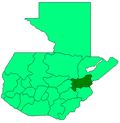Zacapa | |
|---|---|
Municipality | |
 | |
| Coordinates: 14°58′N 89°32′W / 14.967°N 89.533°W | |
| Country | |
| Department | |
| Municipality | Zacapa |
| Government | |
| • Type | Municipal |
| • Mayor | Julio Sanchez |
| Area | |
| • Municipality | 397 km2 (153 sq mi) |
| Elevation | 120 m (390 ft) |
| Population (Census 2018) | |
| • Municipality | 60,424[1] |
| • Density | 152/km2 (390/sq mi) |
| • Urban | 60,370[2] |
| • Ethnicities | Ladinos |
| • Religions | Catholicism Evangelicalism |
| Climate | BSh |
| http://www.inforpressca.com/zacapa/ | |
Zacapa (Spanish pronunciation: [saˈkapa]) is the departmental capital municipality of Zacapa Department, one of the 22 Departments of Guatemala. It is located approximately 112 kilometres (70 mi) from Guatemala City.
Sports
[edit]Football club Deportivo Zacapa competes in Guatemala's top division and play their home games at the Estadio David Ordoñez Bardales. Their team mascot is the Gallo (rooster).
Etymology
[edit]Historian and poet, Capitán Don Francisco Antonio De Fuentes Y Guzmán notes in his Remembrance Florida, the name Zacapa derives from Nahuatl Zacatl meaning grass or weed, and apan meaning in the river, a word which in turn is composed of atl also meaning water, river, and apan. Zacapa means on the river of grass.
See also
[edit]- Zacapa rum, a brand named for this department.
References
[edit]- ^ Citypopulation.de Population of departments and municipalities in Guatemala
- ^ Citypopulation.de Population of cities & towns in Guatemala
14°58′N 89°32′W / 14.967°N 89.533°W



Well, that’s interesting to know that Psilotum nudum are known as whisk ferns. Psilotum nudum is the commoner species of the two. While the P. flaccidum is a rare species and is found in the tropical islands. Both the species are usually epiphytic in habit and grow upon tree ferns. These species may also be terrestrial and grow in humus or in the crevices of the rocks.
View the detailed Guide of Psilotum nudum: Detailed Study Of Psilotum Nudum (Whisk Fern), Classification, Anatomy, Reproduction